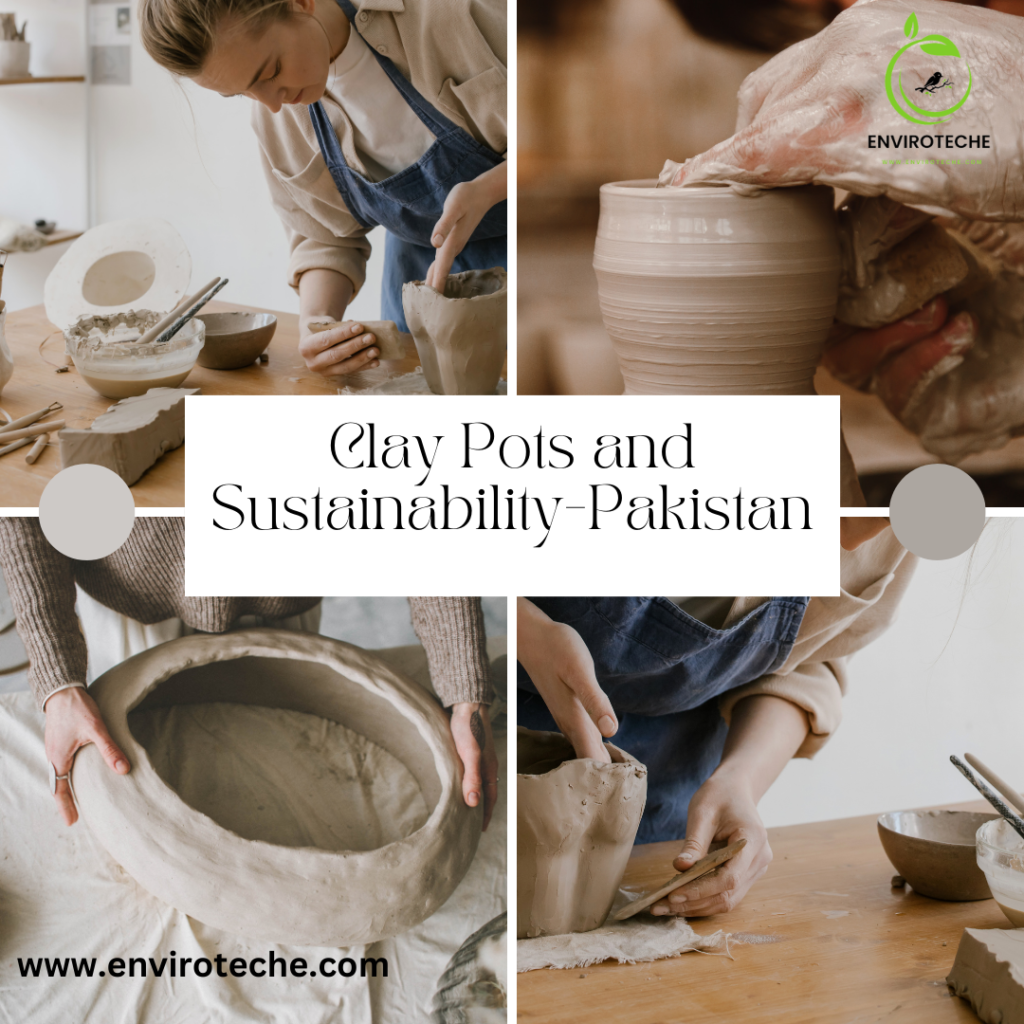
Table of Contents
Clay Pots and Sustainability-Pakistan
Where can clay pots be found in Pakistan?
Clay pots were traditionally used for drinking and storing water in India and Pakistan. Before partition, the Hindu potters also made temples, and idols with clay. Later on, they left those areas. Their remnants can be found in Pakistan. Chalcolithic pots from ten thousand years ago, the red slipped ware with chocolate designs and the polished redware are the remains of Harappan and derived cultures. Mutkas were used to store water and Hanids were for cooking.
These pots have their name because a popular meat dish called Handi was cooked and served in them. Pots have been used in India for utilitarian purposes for many years. It is being used as art as well.
Even today, people use them for storing water in rural areas because there are no refrigerators. In Pakistan, there are no attached workshops in many shops anymore. The workshops have been shifted away from the cities due to kilns for firing. In old times, potters had workshops at the riverbank where markets or bazaars were established.
Goods are brought from Gujrat, Gujranwala, Attock, and other cities for stock. Our country’s tradition of pottery to create decorative items, toys, stoves, and utensils is hundreds of centuries old. It still thrives in many villages and cities in Pakistan. However, the number of shops has reduced. Vendors sell simple and colorful clay pots to attract customers.
How is a clay pot made? Clay Pots and Sustainability-Pakistan
First raw materials such as clay, lacquer, and detergents are arranged. Colors and a small dish are also required. The most important component is clay because it makes the body of a pot. The potter shapes the vessel into the desired item. The pot’s base should be strong because it makes it more durable. The pot is then dried and baked and finally, it’s ready. These pots can also be made at your house.
What are the traditional advantages of storing and drinking water from a clay pot?
There are many benefits of using a clay water pot. Clay pots keep the water cool in the summer. In rural areas, people who can’t afford refrigerators can use them to store water. Not only water but food as well. The practice of drinking water from a clay pot also improves metabolism. It also protects the water from toxic chemicals which are present in containers made of plastic. Water in clay pots has a sweet taste and is much better than water that is filtered.
Clay pots designs and paintings
Pots not only store water but can also be sold or kept as a piece of artwork. Colorful clay pots are being sold online or through vendors. They are used to decorate any place. Although their demand has decreased over the years, we see them in exhibitions, museums, and festivals because they keep the culture alive.
How are clay pots eco-friendly?
When I learned about the advantages of clay pots, I felt I should buy them from a vendor and do some artwork. When I asked the price, I was shocked. They were so cheap and beautiful. Imagine having the skill and talent to mold clay into different shapes and then selling at less rate. One large pot has a maximum price of Rs. 150-200. I took so many small and large clay items, collected old ribbons, laces, and buttons, and bought some glitter, glue, and acrylic paints to paint without thinking much about what design I will make. It was so therapeutic. Although I am an environmentalist, I have always done research and writing, but clay pot painting made my life colorful.
I realized that it has so many advantages other than just painting. It can be a good business with potential where you can buy clay pots conveniently, make different designs, and sell them. Artists make things and earn a lot. We rarely appreciate potters who work for their bread and butter. We all are artists in our way.
Therefore, the advantages of earthen pots for the environment and sustainability need to be observed and elaborated. People were close to nature. They used to take raw materials and make things for their benefit. Our behaviors are still the same. Times have changed but also the priorities over thousands of years.
Revival of traditional art is so important. Colorful pots decorate the house. It has a positive psychological impact. Not only painting clay pots is a therapy, but only looking at these unique patterns takes you back to the ancient world. Usually, the simple brown pots are used to store water and food.
The colorful ones have more value. There are fewer chances of breaking when kept in a safe place or shelf. It has helped me in improving my art skills. When you make something by yourself, you feel the day didn’t go wasted and it keeps you going. Old souls like me will relate and connect with my world.
Modern designs such as cartoons, flowers, and patterns can be drawn on clay pots in addition to traditional art to attract people of all age groups. Only a few acrylic paint brushes, some paint, discarded or leftover materials at home previously used for stitching, or any other purpose that you find suitable for art will do the work.
Some glitter glue and scissors, that’s it! This way, you can create your art piece within 1 to 2 hours at a cheap rate. Therefore, earthen pots are eco-friendly because we don’t have to burn them. They decompose into nature without affecting the environment. In addition to their benefits, the decomposition process shows they are sustainable.
Frequently Asked Questions (FAQs)
1. Where can I find clay pots in Pakistan?
Clay pots can be found in different markets and shops across Pakistan, mainly in rural areas. They are available online as well through vendors.
2. How are clay pots traditionally used in Pakistan?
Traditionally, clay pots in Pakistan were used for drinking and storing water. They were also used for cooking, and some were even used to make dishes such as “Handi.”
3. How are clay pots made?
Clay pots are crafted from raw materials like clay, lacquer, and detergents. The potter shapes the vessel, dries it, and then bakes it to create the final product.
4. What are the advantages of using clay pots for storing and drinking water?
Clay pots keep water cool, making them ideal for hot climates. They are an affordable option for those who cannot afford refrigeration. Drinking water from clay pots can also have health benefits and improve metabolism. Moreover, they protect water from harmful chemicals often found in plastic containers.
5. Do clay pots have artistic value?
Yes, clay pots can be used as decorative pieces and artwork. They come in various designs and colors, making them suitable for decoration. You can find them in exhibitions, museums, and festivals, contributing to the preservation of local culture.
6. How are clay pots eco-friendly?
Clay pots are eco-friendly because they are made from natural materials and decompose naturally without harming the environment. They do not require the energy-intensive firing process that other pottery materials like ceramics do.
7. Can we paint clay pots as a creative activity?
Absolutely! Painting clay pots is a therapeutic and creative activity. You can use acrylic paints and various designs, both traditional and modern, to decorate clay pots. It’s an eco-friendly way to engage in art and craft.
8. Where can I buy clay pots for painting or decoration?
Clay pots for painting and decoration can be purchased from local vendors, craft stores, or online marketplaces. They are usually affordable and come in various sizes.
9. Are there any specific tips for painting clay pots?
When painting clay pots, you can use acrylic paints, brushes, and other materials like glitter glue, ribbons, and buttons to create unique designs. Let your creativity flow, and don’t worry about making mistakes; it’s all part of the artistic process.
10. How can I contribute to sustainability by using clay pots?
By using clay pots for storing water and as eco-friendly art pieces, you promote sustainability. Clay pots decompose naturally and do not contribute to environmental pollution, making them a green choice for both utility and artistic expression.
Author Detail:
Arooj Fatima
Department of Environmental Sciences National University of Sciences and Technology (NUST), Islamabad
Check Other Scholarships:
- FREE Earth-inspired courses
- The Graduate Application Portal for King Fahd University, Saudi Arabia is open.
- International Excellence Scholarship 2023-24
- Scholarship in USA
Clay Pots and Sustainability-PakistanClay Pots and Sustainability-Pakistan Clay Pots and Sustainability-Pakistan Clay Pots and Sustainability-Pakistan Clay Pots and Sustainability-Pakistan Clay Pots and Sustainability-Pakistan Clay Pots and Sustainability-Pakistan Clay Pots and Sustainability-Pakistan Clay Pots and Sustainability-Pakistan Clay Pots and Sustainability-Pakistan Clay Pots and Sustainability-Pakistan Clay Pots and Sustainability-Pakistan Clay Pots and Sustainability-Pakistan Clay Pots and Sustainability-Pakistan
